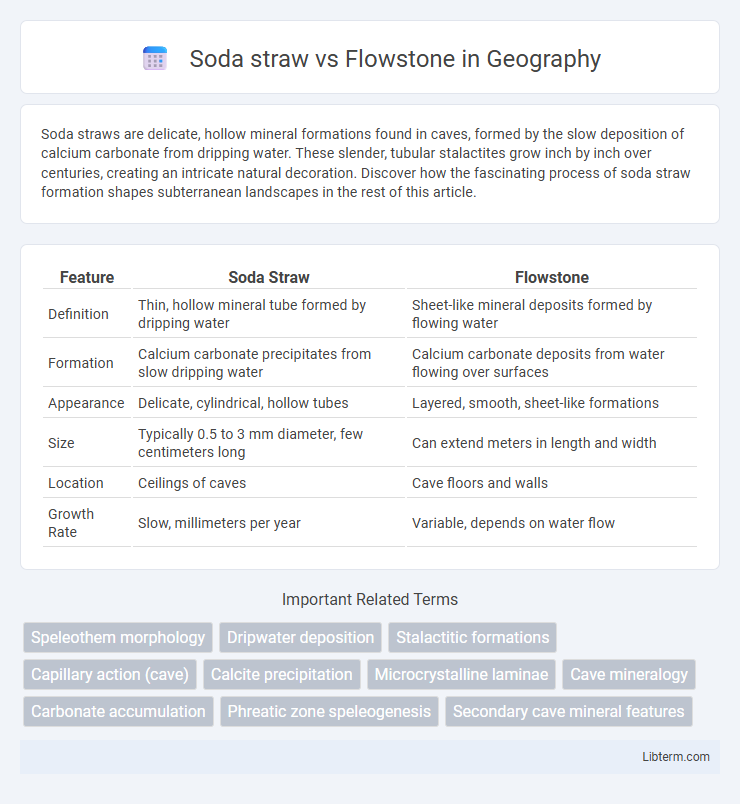Soda straws are delicate, hollow mineral formations found in caves, formed by the slow deposition of calcium carbonate from dripping water. These slender, tubular stalactites grow inch by inch over centuries, creating an intricate natural decoration. Discover how the fascinating process of soda straw formation shapes subterranean landscapes in the rest of this article.
Table of Comparison
| Feature | Soda Straw | Flowstone |
|---|---|---|
| Definition | Thin, hollow mineral tube formed by dripping water | Sheet-like mineral deposits formed by flowing water |
| Formation | Calcium carbonate precipitates from slow dripping water | Calcium carbonate deposits from water flowing over surfaces |
| Appearance | Delicate, cylindrical, hollow tubes | Layered, smooth, sheet-like formations |
| Size | Typically 0.5 to 3 mm diameter, few centimeters long | Can extend meters in length and width |
| Location | Ceilings of caves | Cave floors and walls |
| Growth Rate | Slow, millimeters per year | Variable, depends on water flow |
Introduction to Cave Formations
Soda straws are slender, hollow mineral tubes that form as water drips slowly from cave ceilings, depositing calcium carbonate layer by layer. Flowstone develops on cave floors or walls as mineral-rich water flows over surfaces, creating smooth, sheet-like deposits of calcite or other carbonate minerals. Both formations illustrate distinct processes of speleothem growth driven by water movement and mineral precipitation.
What Are Soda Straws?
Soda straws are delicate, hollow mineral tubes formed from calcium carbonate deposits that hang from cave ceilings, typically measuring a few centimeters to several inches long. These speleothems develop as water rich in dissolved calcium bicarbonate drips slowly, allowing mineral deposits to accumulate at the edges, creating a thin, straw-like structure. Unlike flowstone, which forms over cave floors and walls as mineral-rich water flows and spreads out, soda straws remain tubular and fragile, often serving as precursors to stalactites when mineral deposition thickens their walls.
Understanding Flowstone
Flowstone forms when mineral-rich water flows over cave surfaces, depositing layers of calcite or other minerals that create smooth, sheet-like formations. Unlike soda straws, which are delicate tubular stalactites formed by dripping water, flowstones develop through continuous water film movement that creates broad, solid sheets. Understanding flowstone formation helps in interpreting cave hydrology and mineral deposition processes in speleology.
Formation Processes Compared
Soda straws form through the slow deposition of calcium carbonate as water drips from cave ceilings, allowing tiny hollow tubes to develop over time. Flowstone forms when mineral-rich water flows over walls or floors, depositing layers of calcite that build up smooth, sheet-like formations. The key difference lies in soda straws growing downward from dripping water, while flowstone accumulates as continuous sheets from flowing water.
Key Differences: Soda Straw vs Flowstone
Soda straws are thin, hollow mineral tubes formed by the slow deposition of calcium carbonate from dripping water in caves, whereas flowstone consists of layered deposits of calcite or other minerals that form sheets over cave surfaces. Soda straws grow vertically and remain delicate, while flowstone develops as broad, often smooth sheets resulting from water flowing over walls or floors. The primary difference lies in formation processes: soda straws grow through water dripping at a point, whereas flowstone accumulates via flowing water spreading mineral deposits over larger areas.
Visual Characteristics and Identification
Soda straws are delicate, hollow mineral tubes that hang from cave ceilings, typically measuring only a few millimeters in diameter and resembling thin, translucent straws. Flowstones form as sheet-like deposits of calcite or other minerals, coating cave walls or floors with smooth, rippled surfaces that glisten with moisture and range from thin veneers to thick, layered sheets. Identifying soda straws involves inspecting their fragile, cylindrical shape and open ends, while flowstones are recognized by their continuous, often wavy layers of calcite that create a glossy, curtain-like appearance.
Environmental Conditions for Development
Soda straws form in environments with slow, consistent dripping of mineral-rich water, typically in caves with stable humidity and minimal airflow to prevent premature evaporation. Flowstone develops where water flows over large surfaces, requiring a steady supply of calcium carbonate and conditions that promote sheet-like deposition rather than drop-by-drop formation. Both formations depend on temperature stability and mineral saturation levels, but their distinct shapes reflect differing water movement and evaporation rates.
Importance in Cave Geology
Soda straws and flowstone are crucial speleothems that reveal cave formation processes and mineral deposition patterns. Soda straws form as delicate, hollow tubes of calcium carbonate, indicating slow drip rates and water chemistry in caves. Flowstone develops from layers of calcite or other minerals deposited by flowing water, providing insights into historical climate variations and hydrological conditions within the cave system.
Preservation and Conservation Issues
Soda straws are delicate, hollow mineral tubes susceptible to breakage from even minor physical disturbance, requiring strict access control and minimal human interaction for preservation. Flowstone forms from more substantial calcite deposits, making it more resilient but still vulnerable to damage from water contamination and surface abrasion, necessitating careful environmental monitoring. Both formations face threats from changes in cave air composition and microbial contamination, highlighting the need for controlled visitor impact and habitat conservation strategies.
Conclusion: Choosing Between Soda Straw and Flowstone
Choosing between soda straw and flowstone formations depends on the desired cave feature and growth rate. Soda straws are delicate, hollow tubes that grow slowly, ideal for intricate stalactite development, while flowstone forms from sheet-like mineral deposits, creating smooth, solid surfaces with a faster accumulation. Understanding geological processes and environmental conditions enhances effective cave conservation and study.
Soda straw Infographic

 libterm.com
libterm.com